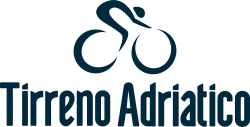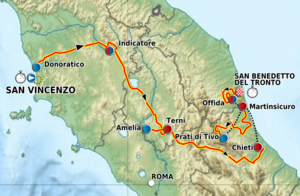Tirreno–Adriatico facts for kids
 |
|
| Race details | |
|---|---|
| Date | Mid March |
| Region | Central Italy |
| English name | Tyrrhenian–Adriatic |
| Local name(s) | Tirreno–Adriatico |
| Nickname(s) | La corsa dei due mari The Race of the two Seas |
| Discipline | Road |
| Competition | UCI World Tour |
| Type | Major one week stage race |
| Organiser | RCS Sport – Gazzetta dello Sport |
| History | |
| First edition | 1966 |
| Editions | 60 (as of 2025) |
| First winner | |
| Most wins | |
| Most recent | |
The Tirreno–Adriatico is a famous bike race in Italy. It is also known as the "Race of the Two Seas". This is because cyclists race between the Tyrrhenian Sea on the west coast and the Adriatic Sea on the east coast. It is a very important race for professional male cyclists. Many riders use it to get ready for bigger races like the Giro d'Italia.
The first race happened in 1966 and had three stages. A stage is one part of a multi-day race. Since 2002, the race has had seven stages. The final stage always finishes in San Benedetto del Tronto by the Adriatic Sea. A cyclist from Belgium, Roger De Vlaeminck, has won the race the most times. He won six times in a row in the 1970s!
Contents
History of the Race
The Tirreno–Adriatico started in 1966. A cycling club in Lazio, Italy, called Forze Sportive Romane, created it. Most big Italian bike races were in Northern Italy. So, this new race was called "Tre Giorni del Sud," which means "Three days of the South."
Early Years and First Winners
The very first race began on March 11, 1966, in Rome. It ended two days later in Pescara. Dino Zandegù from Italy was the first winner. In 1967, the race became longer, with five stages. Franco Bitossi won that second edition.
The 1970s: A Champion's Era
In the 1970s, the Tirreno–Adriatico became a great warm-up race. It was perfect for cyclists getting ready for the big Milan–San Remo race, which happened a week later. Roger De Vlaeminck, a famous Belgian cyclist, dominated the race. He won it six times in a row! After his amazing wins, two Italian cycling stars, Giuseppe Saronni and Francesco Moser, each won the race twice.
Growing Bigger: 1980s and 1990s
From 1984 to 2001, the race grew even more. It had between six and eight stages. The starting points also moved more towards the northern part of Central Italy. In the 1990s, Tony Rominger from Switzerland and Rolf Sørensen from Denmark each won the race twice.
Modern Era: Seven Stages and World Tour
Since 2002, the Tirreno–Adriatico has been a seven-stage race. It starts on Italy's western coast, by the Tyrrhenian Sea. Then, it crosses the country to finish in San Benedetto del Tronto on the Adriatic Sea.
In 2005, it became part of the UCI ProTour, which was a top series of races. Later, it became part of the UCI World Tour in 2011. This means it is one of the highest-level professional men's races in the world.
In recent years, the race often includes tough mountain stages in the Apennines. Many cyclists who compete in Grand Tours (like the Tour de France) use this race to test their skills early in the season. Famous winners since 2010 include Tour de France champions like Vincenzo Nibali, Cadel Evans, and Alberto Contador. Colombian climber Nairo Quintana won the race in 2015 and again in 2017. The 2020 race was held in September because of the COVID-19 pandemic.
Race Route
In its early days, the Tirreno–Adriatico often started near Rome or even Naples. Since the 1990s, it usually starts in seaside towns on the Tuscan coast. This is on the Tyrrhenian Sea side. Then, the race crosses the middle of the Italian peninsula to the Adriatic Sea on the east coast.
The race lasts for seven days. It has different types of stages:
- Some stages are for sprinters, who are very fast on flat roads.
- Some stages are for climbers, who are good at going up hills.
- There are usually one or two time trial stages. In a time trial, cyclists race against the clock alone.
- There is often at least one uphill sprint finish for "puncheurs." These riders are good at short, powerful climbs.
The route for the 2015 race is a good example of how it suits different types of riders. The race often starts on a Wednesday with a short team time trial. Then, there are stages for sprinters and a stage that ends on a short hilltop. The middle stages, usually on the weekend, are the tough mountain stages. The Tirreno–Adriatico always finishes on a Tuesday in San Benedetto del Tronto. This town is in the Marche region of Italy.
Trophy and Leader's Jersey
Since 2010, the winner of the Tirreno–Adriatico gets a special trophy. It is a large, golden trident. A trident is a three-pronged spear, like the one carried by Neptune, the Roman god of the sea. Because the race goes from one sea to another, the trophy is officially called the Sea Master Trophy.
Before the race starts, divers from the Italian Coast Guard ceremonially bring the trophy up from the Tyrrhenian Sea. This keeps with the sea theme of the race. The leader of the race wears a blue jersey. This blue color also matches the sea theme.
List of Overall Winners
| Year | Winner | Stages | Distance (km) |
|---|---|---|---|
| 1966 | 3 | 604 | |
| 1967 | 5 | 1,068 | |
| 1968 | 5 | 1,037 | |
| 1969 | 5 | 946 | |
| 1970 | 5 | 913 | |
| 1971 | 5 | 985 | |
| 1972 | 5 | 884 | |
| 1973 | 5 | 582 | |
| 1974 | 5 | 781 | |
| 1975 | 5 | 816 | |
| 1976 | 5 | 882 | |
| 1977 | 5 | 809 | |
| 1978 | 5 | 864 | |
| 1979 | 5 | 916 | |
| 1980 | 5 | 814 | |
| 1981 | 5 | 835 | |
| 1982 | 5 | 820 | |
| 1983 | 5 | 857 | |
| 1984 | 6 | 1,043 | |
| 1985 | 6 | 1,011 | |
| 1986 | 6 | 981 | |
| 1987 | 6 | 936 | |
| 1988 | 6 | 930 | |
| 1989 | 7 | 1,071 | |
| 1990 | 8 | 1,041 | |
| 1991 | 8 | 1,317 | |
| 1992 | 8 | 1,166 | |
| 1993 | 8 | 1,431 | |
| 1994 | 8 | 1,316 | |
| 1995 | 8 | 1,422 | |
| 1996 | 8 | 1,370 | |
| 1997 | 8 | 1,162 | |
| 1998 | 8 | 1,437 | |
| 1999 | 8 | 1,412 | |
| 2000 | 8 | 1,249 | |
| 2001 | 8 | 1,155 | |
| 2002 | 7 | 1,049 | |
| 2003 | 7 | 1,235 | |
| 2004 | 7 | 1,228 | |
| 2005 | 7 | 1,214 | |
| 2006 | 7 | 1,108 | |
| 2007 | 7 | 1,097 | |
| 2008 | 7 | 1,122 | |
| 2009 | 7 | 1,095 | |
| 2010 | 7 | 1,229 | |
| 2011 | 7 | 1,075 | |
| 2012 | 7 | 1,063 | |
| 2013 | 7 | 1,060 | |
| 2014 | 7 | 1,034 | |
| 2015 | 7 | 1,006 | |
| 2016 | 6 | 851 | |
| 2017 | 7 | 1,030.7 | |
| 2018 | 7 | 992.5 | |
| 2019 | 7 | 1,048.5 | |
| 2020 | 8 | 1,138.1 | |
| 2021 | 7 | 1,104.1 | |
| 2022 | 7 | 1,133.9 | |
| 2023 | 7 | 1,170.5 | |
| 2024 | 7 | 1,119.0 | |
| 2025 | 7 | 1,147.5 |
Cyclists with Multiple Wins
| Wins | Rider | Editions |
|---|---|---|
| 6 | 1972, 1973, 1974, 1975, 1976, 1977 | |
| 2 | 1978, 1982 | |
| 1980, 1981 | ||
| 1987, 1992 | ||
| 1989, 1990 | ||
| 2012, 2013 | ||
| 2015, 2017 | ||
| 2019, 2023 | ||
| 2021, 2022 |
Wins by Country
| Wins | Country |
|---|---|
| 24 | |
| 8 | |
| 5 | |
| 4 | |
| 3 | |
| 2 | |
| 1 |
See also
 In Spanish: Tirreno-Adriático para niños
In Spanish: Tirreno-Adriático para niños


